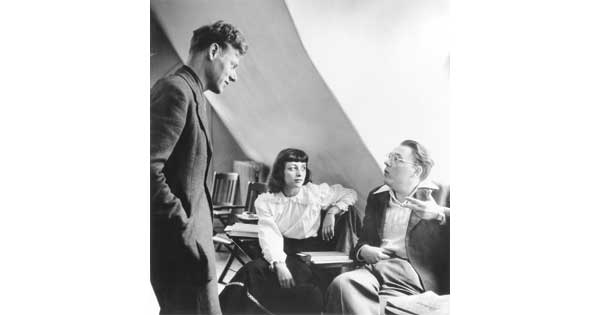
The Double Life of Paul De Man, by Evelyn Barish, Liveright, 560 pp., $35
A little more than 25 years ago, a Belgian scholar named Ortwin de Graef came upon a moldering stack of the newspaper Le Soir (volé) in a Brussels archive. As he read through the yellowed issues of the collaborationist newspaper, published during the German occupation of Belgium, de Graef made a startling discovery—startling, at least, on our side of the Atlantic. One of the founders of deconstruction, Paul de Man, when still an obscure journalist with literary aspirations, wrote more than a hundred articles for the paper. They were penned in clear and lucid French, so different from the cryptic language of his later theoretical writings—and that, precisely, was the rub: a number of the articles were strongly anti-Semitic, and others promoted an aesthetic that dovetailed with that of the Thousand-Year Reich.
Pairing photos of Nazi storm troopers and de Man, Newsweek featured the story on its cover. These were the faces that launched a thousand articles and books, conferences and colloquia. And, of course, spurred polemics and philippics, public confessions and private clashes as former colleagues, students, and disciples grappled with the import of these events. Was deconstruction less a means for prying open a literary text than a means for closing shut one’s past? How was it that the same methodical unmasking of narra- tive strategies that de Man urged his followers to apply to literary texts was never turned on the man himself?
Evelyn Barish, the author of a well-received biography of Ralph Waldo Emerson, takes up these questions in her painstaking and probing account of the formative years of de Man’s life. Barish had briefly been a colleague of de Man’s at Cornell; once the scandal broke, she was as shocked as most everyone else who had been pulled into his powerful orbit. This book, which carries de Man’s story up to the early 1960s, is the result of her drive to solve the puzzle of his life. Barish studied civilian and military court records as well as state archives and discovered, stunningly, that de Man was not just a wartime collaborator who dabbled in anti-Semitism, but also a financial swindler and serial liar of epic proportions.
Scarred by the suicide of an emotionally distant and chronically depressed mother, de Man revealed himself to be a bright, but feckless engineering student in interwar Belgium, repeatedly failing or bailing out of his exams. But he was a tireless reader and autodidact and, having settled in Brussels, soon drifted into a circle of students with literary and political ambitions. Like many young Europeans during this era, they scorned humanist values and parliamentary politics; the true enemy, they believed, was less Fascist Italy or Nazi Germany than democracy itself, which had run its decadent and destructive course.
Few thinkers made this claim as compellingly as de Man’s uncle, Henri de Man. A charismatic politician who had begun his career on the Left and ended it as a collaborationist prime minis- ter, Henri de Man played a primordial role in his nephew’s life. As Barish notes, for much of his adulthood, de Man repeatedly identified Henri as his father. Not only were the nephew’s complex emotional needs reflected in this assign- ment of paternity, but so too was his attachment to his uncle’s appalling ideological compass. The younger de Man proved no slouch when it came to working with the enemy. There were, of course, the anti-Semitic articles unearthed by de Graef, particularly “The Jews in Present-Day Literature.” Barish deftly contextualizes these pieces, concluding that, unlike the vulgar writings of his colleagues, de Man’s urbanity “had the special strength of giving an upper-class imprimatur to their crudity.”
 More remarkable, however, were de Man’s other unsung activities under the shadow of the Nazi occupation. There was his effort, ultimately unrealized, to launch Cahiers Européens, a collaborationist journal that a postwar Belgian prosecutor damned as treasonous. When not helping to lay the intellectual foundations in Belgium for the Thousand-Year Reich, de Man was busy emptying the coffers of Agence Dechenne, a large publishing house he directed. He assigned himself a kingly salary, pocketed the advances he promised to authors, stiffed those who published with the company, and wined and dined those willing to invest in his private ATM. Even after Belgium’s liberation, de Man continued to bamboozle authors and investors, creating a shell publishing company called Hermès. He published just one book in his firm’s short and dismal life, while simultaneously draining it of its entire operating capital of 1,450,000 Belgian francs. In 1951, a Brussels court sentenced him to six years in prison for embezzlement and forgery.
More remarkable, however, were de Man’s other unsung activities under the shadow of the Nazi occupation. There was his effort, ultimately unrealized, to launch Cahiers Européens, a collaborationist journal that a postwar Belgian prosecutor damned as treasonous. When not helping to lay the intellectual foundations in Belgium for the Thousand-Year Reich, de Man was busy emptying the coffers of Agence Dechenne, a large publishing house he directed. He assigned himself a kingly salary, pocketed the advances he promised to authors, stiffed those who published with the company, and wined and dined those willing to invest in his private ATM. Even after Belgium’s liberation, de Man continued to bamboozle authors and investors, creating a shell publishing company called Hermès. He published just one book in his firm’s short and dismal life, while simultaneously draining it of its entire operating capital of 1,450,000 Belgian francs. In 1951, a Brussels court sentenced him to six years in prison for embezzlement and forgery.
By then, however, the charlatan had slipped out of his native Belgium and into his new identity as literary theorist in his adopted United States. Tracing de Man’s serpentine trail of lies from New York and Cambridge to Bard College, Cornell, and ultimately Yale, where he settled as the doyen of deconstruction, Barish neatly describes his American life as a “kind of autobiographical Ponzi scheme.”
Such schemes require suckers, and where better to find them than in the groves of academe? By turns charming and sharp tongued, erudite and easygoing, de Man mesmerized colleagues and students, offering what Americans so desperately needed: a seal of approval from a European intellectual. To boot, he was attractive—an adjective Barish applies to de Man like a Homeric epithet—which certainly helped him, as Mary McCarthy, among others, would attest.
Barish does make a few historical slips. Describing the German invasion of 1940, she writes that “the Maginot Line yet again failed to hold—in fact, the Maginot Line was tested just once, in 1940, and held (the Germans invaded to the north, through the Ardennes). Camus was “the Nobel Prize–winning novelist” not in 1948 but in 1957. And it is simply unfair of Barish to compare de Man’s wartime collaboration to the activities of French editor Jean Paulhan, who aided the Resistance. These errors, however, do not distract from an otherwise pungent account.
As Barish reveals, there was also a tragic side to de Man. At potentially great cost to his career, he married a Bard student, to whom he remained faithful and deeply attached; to support his family, he held several teaching jobs simultaneously, including a long stint at Berlitz. He was a generous teacher, as much a mentor as a magician, to his students. Ultimately, a mark of Barish’s achievement is that, by the end of her story, de Man confounds and eludes us no less than he did his contemporaries.

